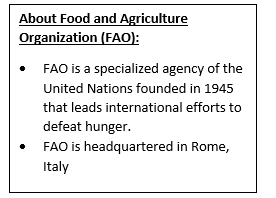SYLLABUS
GS-3: Issues of buffer stocks and food security
Context: Recently, FAO released its State of Food and Agriculture (SOFA) 2025 report which highlights rising global yield loss due to human-induced land degradation.
Key Highlights of the Report
Scale of the Problem

- The report states that about 1.7 billion people live in areas where agricultural output is declining due to human-induced land degradation.
- Eastern and southern Asia have the largest populations affected by degradation-driven yield loss.
- India is among the countries with the highest yield gaps caused by human-induced land degradation.
- Around 3.6 million hectares of cropland are abandoned annually and land degradation plays a major role in this trend.
- The most vulnerable hotspots are in southern Asia and sub-Saharan Africa where land degradation overlaps with poverty and child stunting.
- Nearly 47 million children under five with stunted growth live in severely degraded yield-loss regions.
Deforestation and Land Use Trends
- Agricultural expansion remains the main cause of global deforestation and has shaped land-use patterns for centuries.
- Between 2001 and 2023 global agricultural land reduced by 78 million hectares even as cropland area increased by the same amount.
- Sub-Saharan Africa recorded 69 million hectares of cropland expansion and 72 million hectares of forest loss.
Restoration and Food Security Potential
- The report notes that reversing only 10 percent of human-induced degradation can produce food sufficient for 154 million people every year.
- Restoring abandoned croplands can potentially feed between 292 and 476 million people.
Farm Size and Land Management Patterns
- Farm size has a direct influence on land management and food production outcomes.
- Large farms invest in technology that improves productivity but can worsen degradation over time.
- Small farms operate on vulnerable land and face resource constraints that limit sustainable land use.
- About 85 percent of the world’s farms are under 2 hectares and cultivate only 9 percent of agricultural land.
- Only 0.1 percent of farms are above 1,000 hectares yet control about half of the world’s farmland.
- Large farms in Europe and North America maintain yields through heavy input use which hides land degradation but increases economic and ecological costs.

